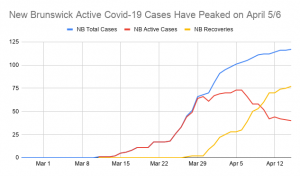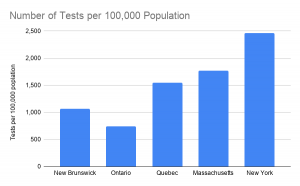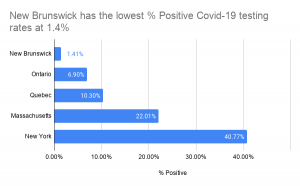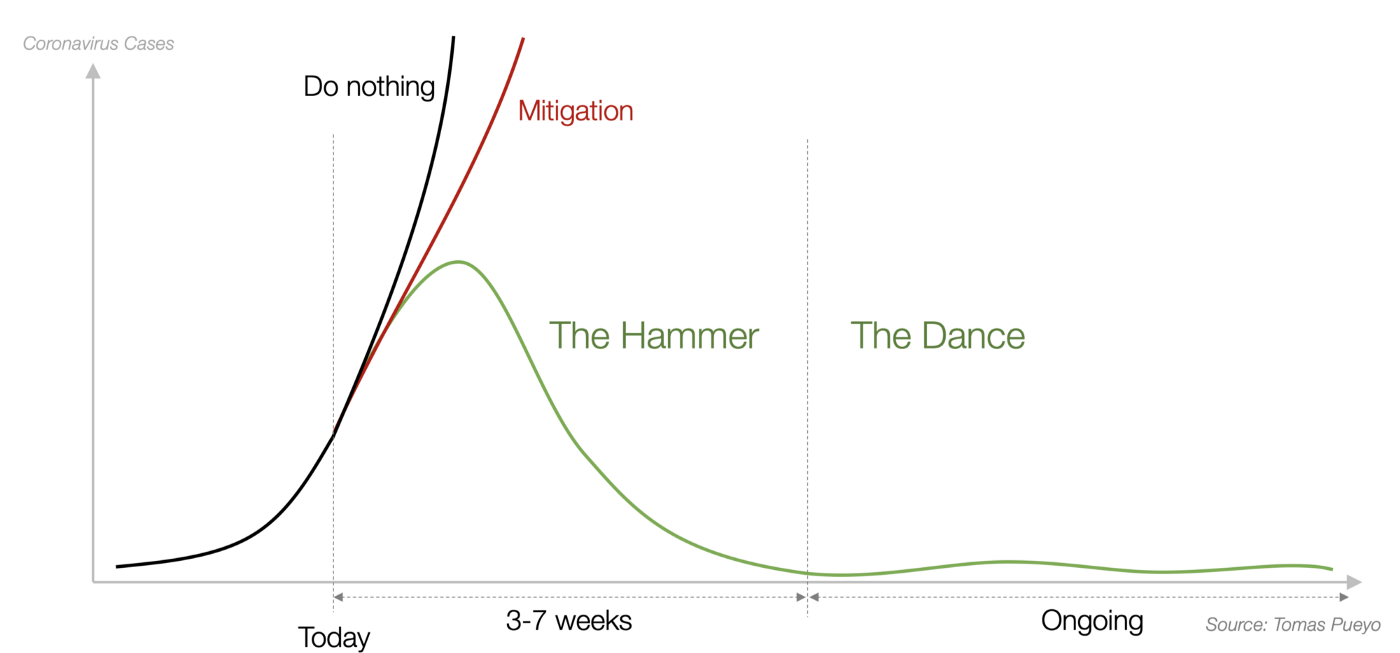Questions and news articles are ramping up this week regarding plans to re-open the economy. Many leaders aren’t ready to talk about it yet. Others are being more aggressive in easing restrictions to help get people back to work. In Spain, they are re-opening factories in spite of seeing more than 3,000 new cases per day because the trend line is improving. But what about New Brunswick? What is the right plan for us?
First, we want to highlight the incredible job that our leaders have done. In New Brunswick, Dr. Jennifer Russell has been a clear and wise decision-maker and a great communicator. Premier Higgs has been decisive in closing the borders, shutting down non-essential businesses, listening to the scientists and experts, and keeping everyone informed. Dominic Cardy’s decision to close schools, which was criticized at the time, now looks brilliant.
The plan has worked.
We have not only flattened the curve, we have planked it. We have succeeded in not overwhelming our health care resources. We have also been lucky, with a lower population density and fewer international travellers.
Tomas Pueyo’s popular article from March 19 advocated for a Covid-19 suppression strategy called, “The Hammer and the Dance.” New Brunswickers have brought “The Hammer” to flatten the curve. Soon we will start “The Dance” — our longer-term effort to keep the virus contained until there is a vaccine while re-opening the economy.
Where do we stand today?

So far, we have zero deaths in New Brunswick from this virus. We reached our peak in “new cases per day” on March 29. On April 5 and 6, we reached our peak in active cases at 73. As of Wednesday, April 15, we have only 40 active cases. In the last seven days, we have seen an average decline of 4 active cases per day. This is great news. Is it enough?
But wait — Aren’t we underestimating the infection rate in New Brunswick due to low testing?
It is a good question. Studies are emerging that show that actual infection rate of the disease is higher than test results have shown, such as this German study, “Covid antibody test in German town shows 15 percent infection rate.”
Some have argued, as in this Global news article that, “Canada may be missing thousands of coronavirus cases, experts say.” We have only performed a total of 8,199 tests in New Brunswick, only about 1 percent of the population. Could we be missing a lot of cases?

New Brunswick’s per capita testing levels are on the low end, but there is another metric that is even more indicative — the percentage of tests that return positive (percent positive). The lower the number of “percent positive” cases the higher the confidence that there is sufficient testing happening.

New York’s 40 percent positive results reveal that the true number of cases is likely much higher in New York than what is being reported.
With our percent positive results at 1.4 percent, New Brunswick’s results are best in class, giving us a more confident picture of the infection rate in New Brunswick compared to that of other regions. Guided by the data, Dr. Russell has progressively expanded testing criteria over the past few weeks.
How do we know when we are ready to re-open the economy?
In this American Enterprise Institute report entitled, “National Coronavirus Response: A ROAD MAP TO REOPENING”, experts offer four criteria as a guideline for cities and regions to make the decision.
The Recommendations are:
- Hospitals in the state (region) must be able to safely treat all patients requiring hospitalization, without resorting to crisis standards of care.
- A state needs to be able to at least test everyone who has symptoms.
- The state is able to conduct monitoring of confirmed cases and contacts.
- There must be a 14-day sustained reduction in new cases (page 3).
For us in New Brunswick, how close are we to meeting these criteria?
- Our health care system has not been overwhelmed. Only 12 people in total have been hospitalized province-wide. We are in great shape for the next phase.
- Our testing in New Brunswick has continued to expand, including as recently as April 13 where testing was expanded to include anyone with 2 out of 5 key symptoms. This is where we want to be.
- In New York, contact tracing has effectively stopped since mid-March due to the widespread nature of the infection. But in New Brunswick, we have been able to investigate each case. We need to ensure we maintain this capacity into the next phase.
- In New Brunswick, our number of new cases has been declining for the past 17 days, since its peak on March 29 (15 new cases). Further, we are also now seeing a steady decline in Net Active cases, from a peak of 73 on April 5/6, to 40 on April 15.
It seems we might be ready for “The Dance”.
What is “The Dance”?
As Prime Minister Justin Trudeau shared this week, we will not likely return to full normalcy until a vaccine emerges in 12–18 months. The Dance is the phase following the suppression of the first wave of the virus. This is the process of taking gradual steps to re-open the economy while remaining vigilant and responsive to any signs of subsequent outbreaks.
What will “The Dance” phase look like for New Brunswick?
We feel that this is a critical time to be giving guidance to New Brunswick businesses. It is the time to plan, prepare and communicate.
Businesses are facing many urgent questions now: Should they spend the money to get their facility ready for summer? Should they stop taking new bookings? Should they spend on advertising, or not? Should they offer that summer student a job or not? Should they invest in implementing new social distancing measures in anticipation of re-opening? Should they let more staff go? All these questions depend on timing. Making the wrong call either way could sink the business.
While dates are uncertain, businesses need guidance on what the next phase might look like. This will result in better decisions and a better recovery.
What questions would the plan address?
On the surface it can seem like a simple matter — just open the economy right? But there are many questions.
One of the consequences of our success is that we have low “herd immunity” so we remain vulnerable. We also live next to hotspots where we typically get a lot of seasonal visitors to Atlantic Canada in July and August. Key questions include:
- How many phases of progressive easing of restrictions should we put in place? What is the criteria for moving from one phase to the next?
- What types of business will be allowed to operate in each phase and why? What new safeguards must we put in place for them to operate?
- Given our proximity to continued hotspots near New Brunswick, should we keep the borders closed during Phase 2 of “The Dance” and for how long?
- Do we encourage tourism/visitors to New Brunswick this summer or not? Here, we must coordinate with the other Atlantic Provinces and ideally arrive at a mutual strategy.
- Should we re-open daycare centers and schools? Is this linked to enabling people to return to work? What new precautions must we put in place?
- What resources (people, technology, etc.) do we need in order to be able to continue to perform rapid testing, contact tracing and monitor quarantines during this phase to prevent a second wave?
- What social distancing guidelines do we put in place for people in the workplace, and other private and public spaces such as seniors homes, sports facilities, restaurants, and performance venues?
Conclusion
We are in a fortunate position in New Brunswick. This has given us the opportunity to lead the recovery. Let’s give our citizens and businesses every opportunity to spring out of this crisis with the lead time and guidance they need to prepare wisely for recovery.
A week-by-week approach will only cause uncertainty and economic loss. We need a plan. We also need to remain flexible to changing conditions. This is the nature of “The Dance”.
Everyone will have a different perspective on the exact right timing and how to strike the balance. There is likely no perfect answer — just a “best answer at the moment”. That’s okay. This is why we need to collaborate and start planning now.
This is the first in a two-part series.
Huddle publishes commentaries from groups and individuals on important business issues facing the Maritimes. These commentaries do not necessarily reflect the opinion of Huddle. To submit a commentary for consideration, contact editor Mark Leger: mark@huddle.today.
Find the full story by Marcel LeBrun and David Alston HERE
